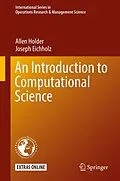Completely up-to-date text designed to address the shortfalls of all existing texts available
End-of-chapter problems throughout and online ancillaries available
Authors based the pedagogy on their own experiences teaching the course
Autorentext
Allen Holder received his B.S. from the University of Southern Mississippi and his Ph.D. from the University of Colorado at Denver. He taught at Trinity University in San Antonio, Texas for nine years before joining Rose-Hulman. He is interested in mathematical programming and its applications in medicine, biology, and healthcare. Professor Holder's work on the optimal design of radiotherapy treatments won the 2000 Pierskalla Award, and he received Rose-Hulman's Outstanding Scholar Award in 2015. He has held several editorial positions and has published with numerous undergraduates. He is a longtime supporter of, and participant in, INFORMS.
Klappentext
This textbook provides an introduction to the growing interdisciplinary field of computational science. It combines a foundational development of numerical methods with a variety of illustrative applications spread across numerous areas of science and engineering. The intended audience is the undergraduate who has completed introductory coursework in mathematics and computer science. Students gain computational acuity by authoring their own numerical routines and by practicing with numerical methods as they solve computational models. This education encourages students to learn the importance of answering: How expensive is a calculation, how trustworthy is a calculation, and how might we model a problem to apply a desired numerical method?
Inhalt
Chapter 1. Solving Single Variable Equations.- Chapter 2. Solving Systems of Equations.- Chapter 3. Approximation.- Chapter 4. Optimization.- Chapter 5. Ordinary Di erential Equations.- Chapter 6. Stochastic Methods & Simulation.- Chapter 7. Computing Considerations.- Chapter 8. Modeling with Matrices.- Chapter 9. Modeling with Ordinary Di erential Equations.- Chapter 10. Modeling with Delayed Di erential Equations.- Chapter 11. Partial Di erential Equations.- Chapter 12. Modeling with Optimization and Simulation.- Chapter 13. Regression Modeling.- Appendix A.
